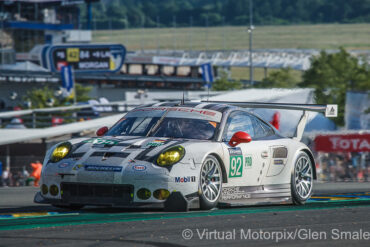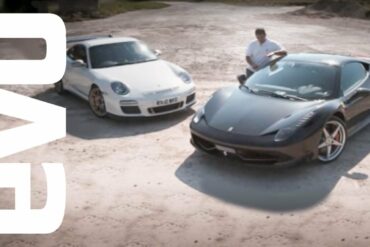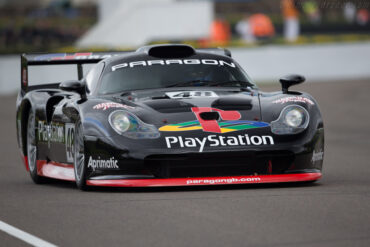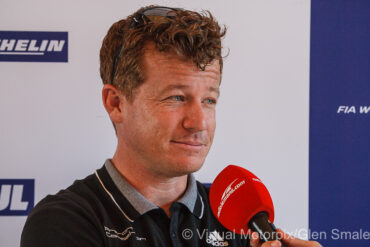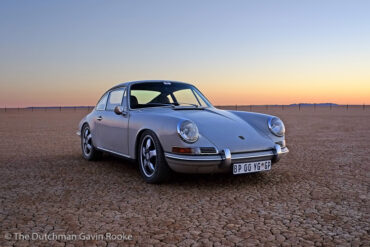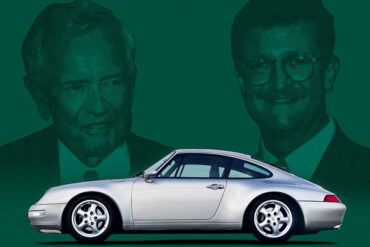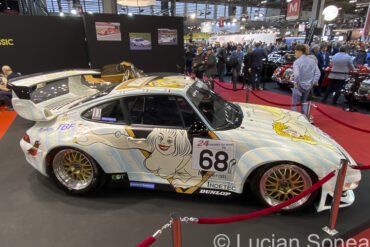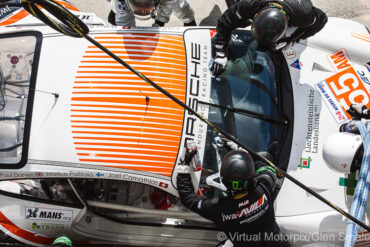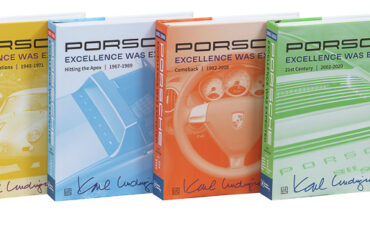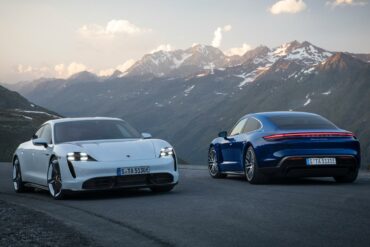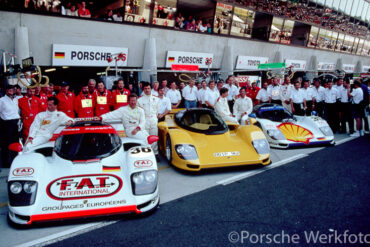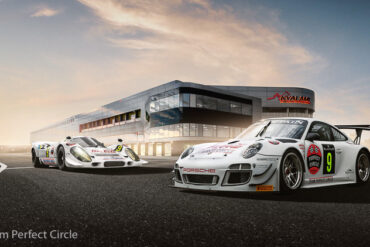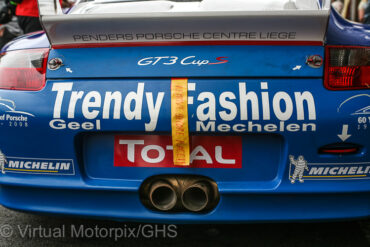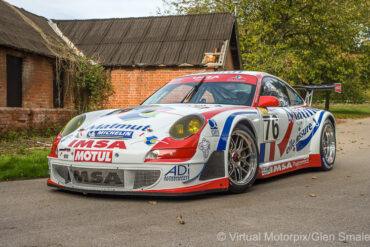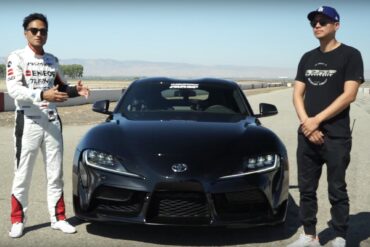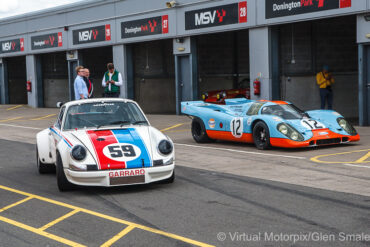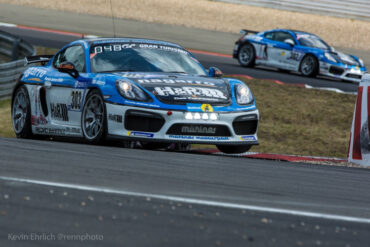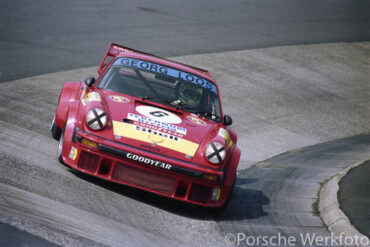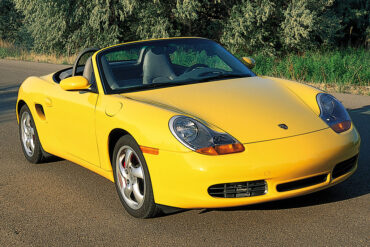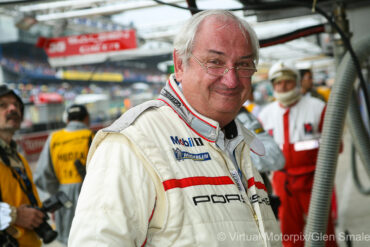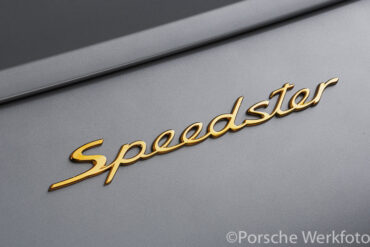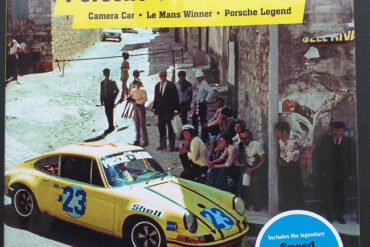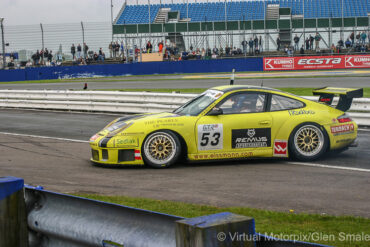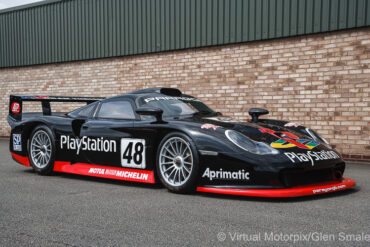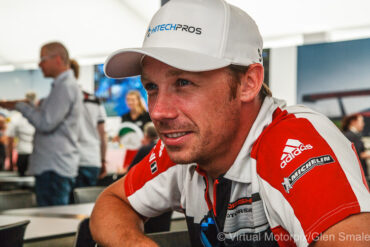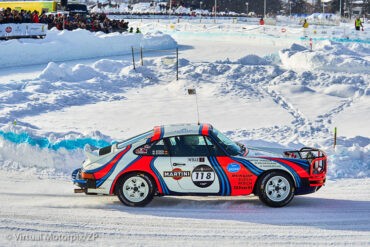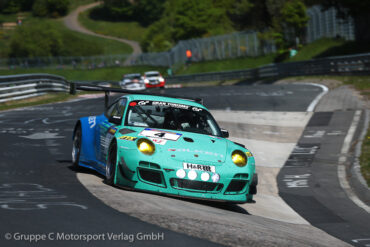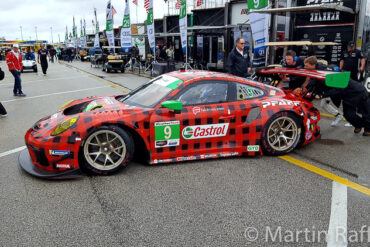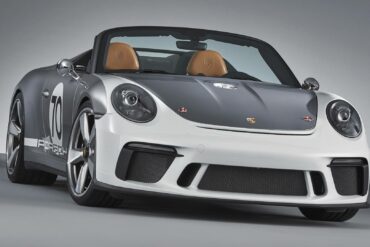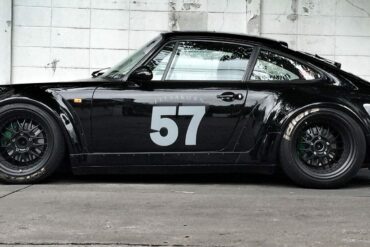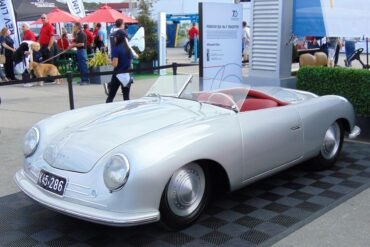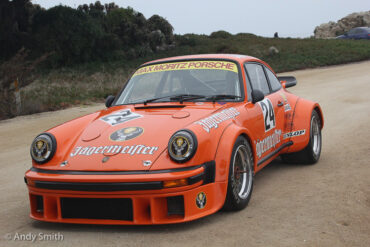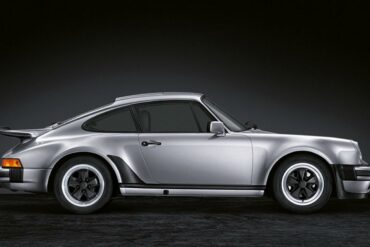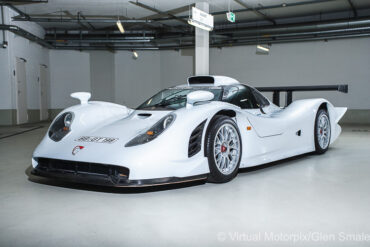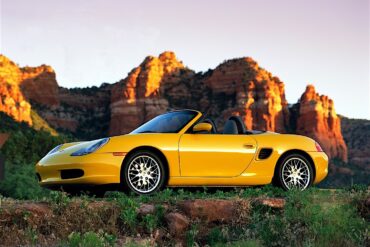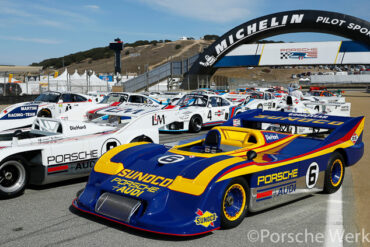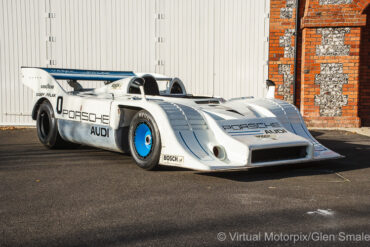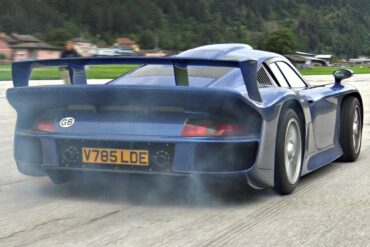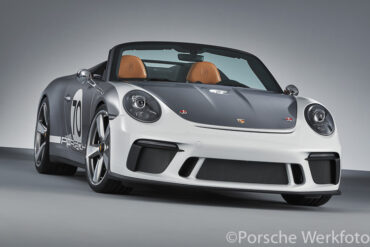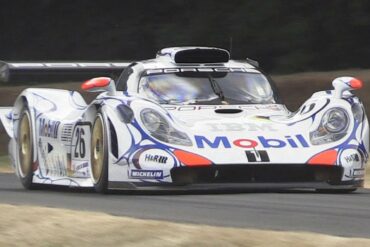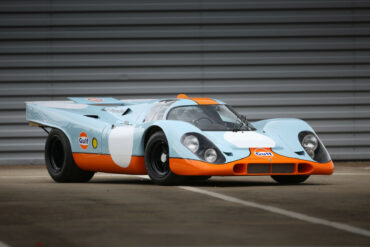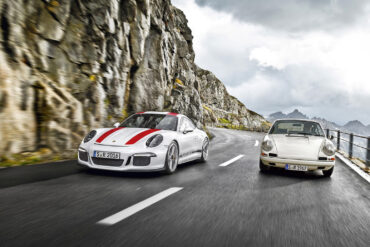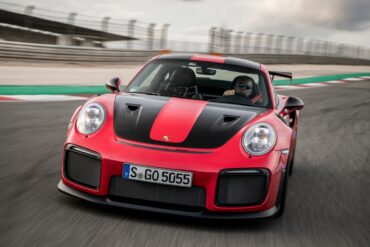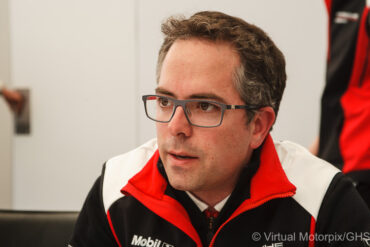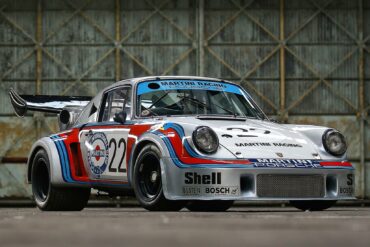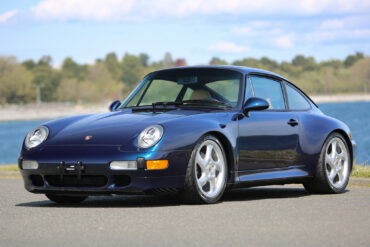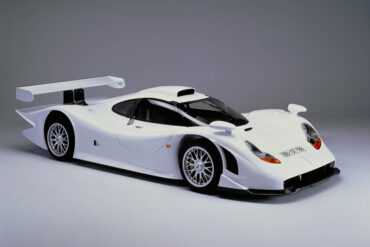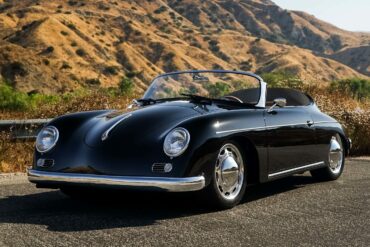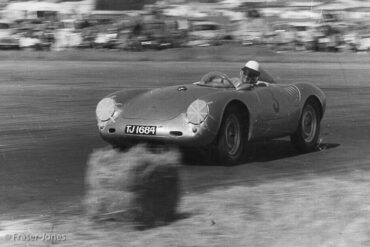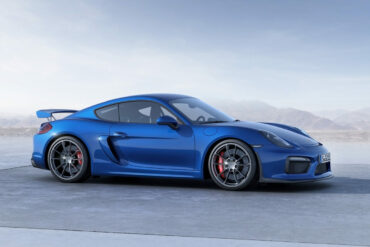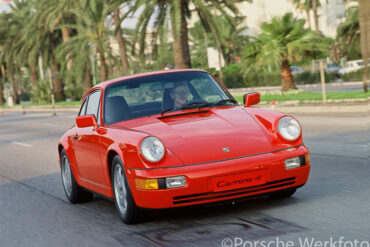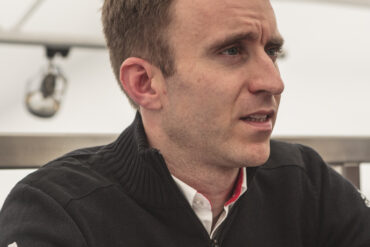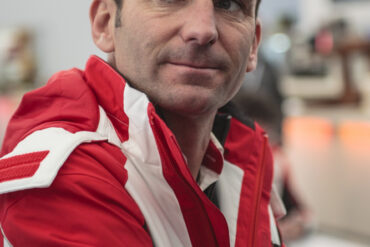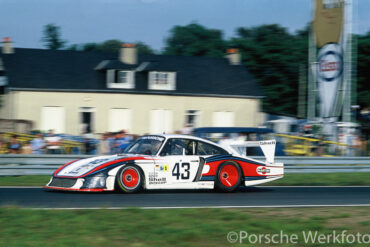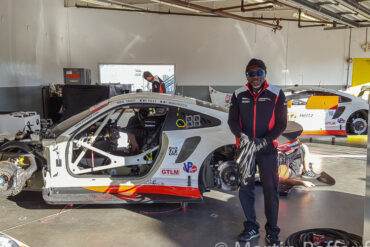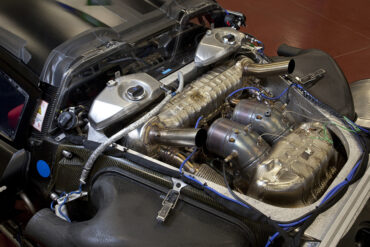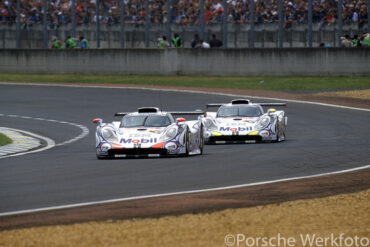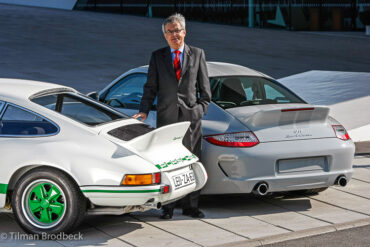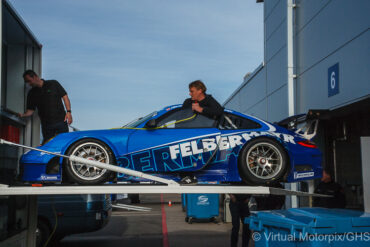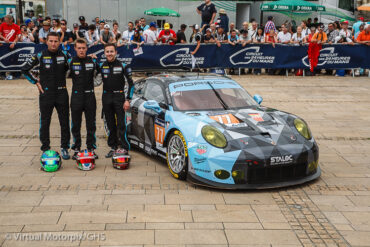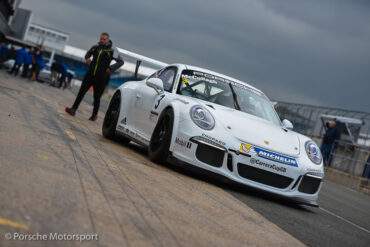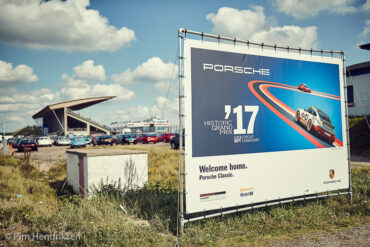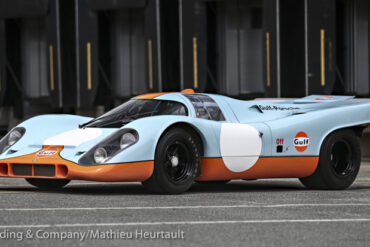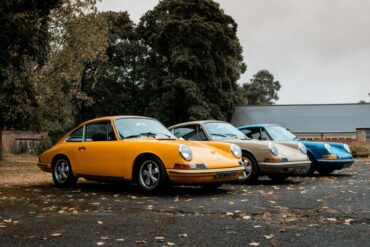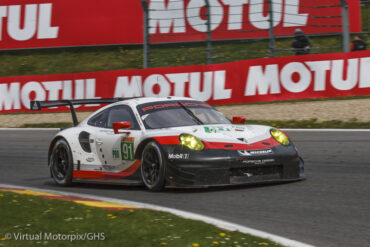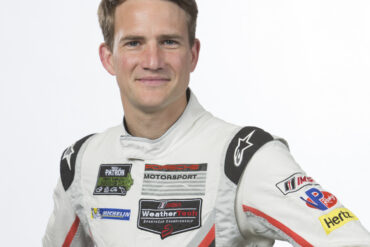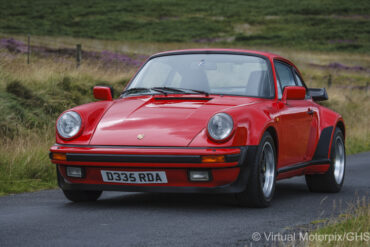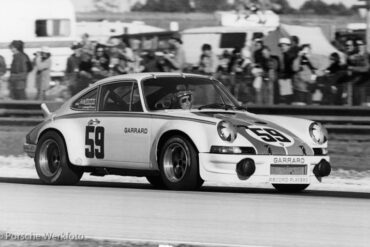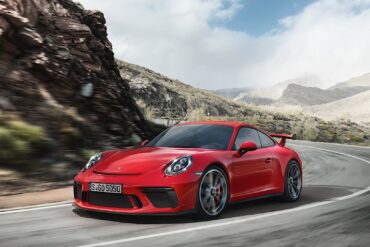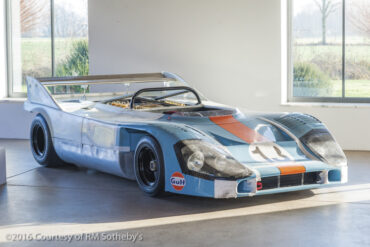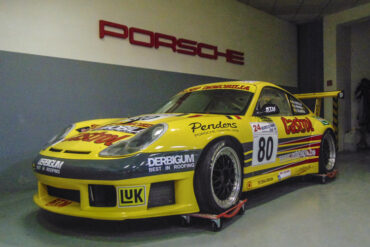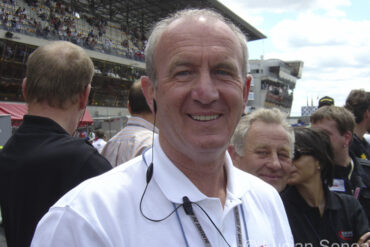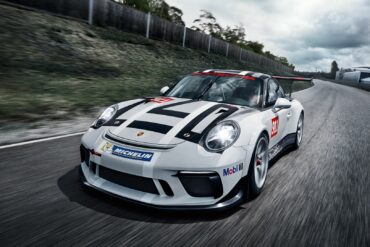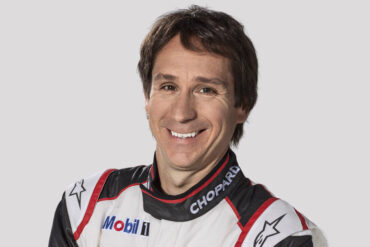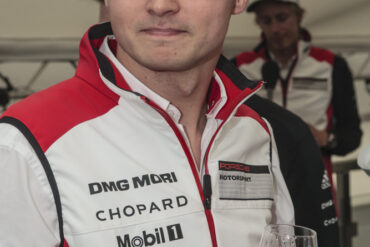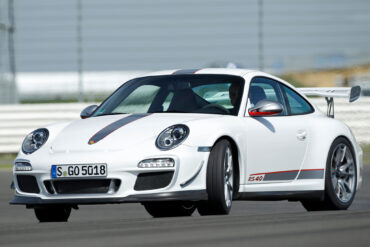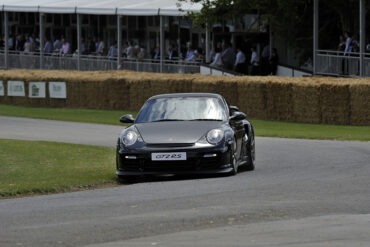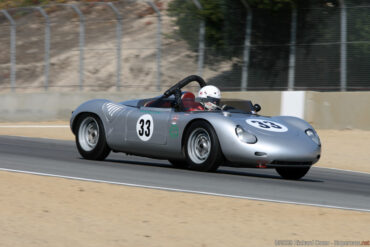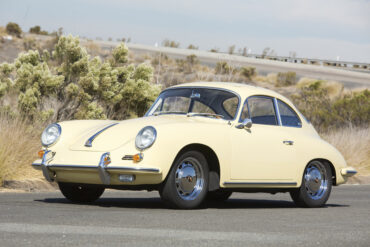Le Mans 24 Hours, 18-19 June 2016: Frédéric Makowiecki, Jörg Bergmeister and Earl Bamber posted a DNF having completed 140...
963 results for
997
Chris Harris Drives The Ferrari 458 Italia & Porsche 911 GT3 RS Ferrari’s latest 562bhp V8 coupe has changed the...
There’s no doubt about it: the 911 GT1 EVO is still one of the best looking Porsches ever made and...
Before: 1968 Porsche 912 1.6-litre 4-cylinder engine developing 90 bhp; after: 2014 Dutchmann Porsche 912 with 2.8-litre 6-cylinder engine developing...
PORSCHE 993 “25 YEARS” 1994–2019: by Andreas Gabriel, Manfred Hering & Thomas Nehlert © Berlin Motor Books Berlin Motor Books,...
1973 Porsche 911 Carrera RS 2.7 Lightweight presented by Serge Heitz Automobile Between 5th and 9th February, the Porte de...
Porsche Sport 2019 – © Gruppe C Motorsport Verlag The 27th publishing of this superb edition of Porsche Sport 2019 by...
Le Mans 24 Hour, 16-17 June 2012: The #55 JWA-Avila Porsche 997 GT3 RSR driven by Paul Daniels, Joël Camathias...
Total 6 Hours of Spa-Francorchamps, 4 May 2019: Imagine the surprise when we arrived at the track, to be greeted...
Porsche: Excellence was Expected by Karl Ludvigsen – © Bentley Publishers For many years, Excellence Was Expected, the book on...
Porsche 996.1 v 996.2: Every Detail Revealed The Porsche 996 Carrera is on a crest of a wave in popularity...
It is expensive, it is fast and it is exceptional. The Porsche Taycan Turbo shows us that Porsche's electric future is going to be great for drivers. The Taycan Turbo feels even relentlessly rapid at any speed and the best part is that it really feels like a Porsche from behind the wheel. The Turbo has the same 93.4kWh battery stack as the Turbo S, and the same 614bhp power output. But when you’re going for it in Performance mode, the Turbo’s overboost power and torque are reduced compared with the Turbo S. It means the Turbo is four-tenths slower to 60 mph from standstill.
Lined up in the pit lane before the 1994 Le Mans 24-Hours, is from the left: #36 962 Dauer Le...
Kyalami Racing Circuit – 2019 Last held officially as a 9-hour race back in 1982, Kyalami will play host to...
Spa 24-Hour, 2 August 2008: The #160 Prospeed Competition Porsche 997 GT3 Cup S was driven by David Loix (B)/David...
Le Mans 24 Hours, 16-17 June 2007: Busy grid just before the start of the race Porsche introduced their new...
Gulf Porsche chassis 917-016 Under the welcoming embrace of sunny California skies over wine country, the Sonoma Speed Festival established...
The Supra Is Super Speedy The 2020 Toyota Supra was less exciting than some people would have hoped, but there’s...
Rennsport Collective, Donington Hall, 20 July 2019: Porsche 996 GT1 Evo 1997 on display with numerous other Porsche classics They...
First Drive in the 992 Carrera 2S The KING of Sports cars!! The motoring icon, the Porsche 911! Let’s explore...
Depending on your view, the Gods of the Green Hell either restored Porsche to its rightful place on the top...
Make no mistake that the Speedster is an absolutely fitting conclusion to the 991-generation. The Porsche 911 Speedster is an ingenious amalgamation of the latest technologies on offer, and the more simple ingredients that have been a principle of driving enjoyment since the invention of automobiles. A 502-horsepower engine, without turbochargers. A modern transmission, with just one clutch. A state-of-the-art suspension and chassis, with an unsullied purity. The list goes on. Perhaps the only drawback is that the Speedster’s rarity and price.
Toine Hezemans in his Brussels home, 2015 One of the Netherlands’ most successful racers, Toine Hezemans is part of a...
In 2000, Porsche gave us the Boxster S. With a 3.2 liter naturally aspirated Flat-6, it was good for 250 bhp and 225 ft lbs of torque, up by 25% on the base 2.7 liter Boxster. Hardward changes, a 6-speed gearbox and all this extra power and torque transformed the Boxster driving experience. From behind the wheel, the Boxster S rushes forward in a way that is missing from the base model, that torque increase really making itself known, especially in the midrange. 0 to 60 mph now takes 5.60 second (compared to 6.5 for the 2.7 L base model). Top speed is 161 mph and the quarter mile is 14.1 seconds.
Norbert Singer, 24 Hours of Le Mans, 1996 Norbert Singer must rank as one of the most successful race engineers...
2019 model Porsche 911 Speedster Last week, at the New York International Auto Show, the iconic new 911 Speedster was...
Porsche 911 ST 2.5: Thomas Imhof, Jürgen Barth and Michael Keyser © Virtual Motorpix/Glen Smale It landed on my desk...
1997 Porsche 911 GT1-109 photographed in June 2016 Porsche 993 GT1 chassis #109 was one of just nine customer racing...
Patrick Pilet in relaxed mood during an interview prior to the 2017 Le Mans 24 Hours We met up with...
Ice Races GP, Zell am See, 19-20 January 2019: #118 Porsche 911 SC driven by Michael Stock After a 45-year...
Falken Motorsports team 2017 Falken Tyre Europe GmbH is the European subsidiary of Japanese tyre manufacturer Sumitomo Rubber Industries Ltd....
Pfaff Motorsports Porsche 911 GT3 R, a rather striking paint scheme! Despite crewing for one of the teams at this...
Le Mans 24 Hours, 13-14 June 1970: A jubilant Hans Herrmann and Richard Attwood are given a ride on the...
Porsche is celebrating their 70 years in the making with the Porsche 911 Speedster Concept car. With the Carrera Cabriolet 4 body as its canvas, the Speedster concept pays homage to its predecessors - most notably, the Porsche 356 1500 Speedster. The limited production Speedster is immediately distinguishable from the current 911 line-up, with its “double bubble” tonneau cover and other unique offerings and design tweaks.
Carrera RS – The Rennsport Reunion VI Edition: Dr. Thomas Gruber/Dr. Georg Konradsheim © T.A.G. Motor Books GmbH The Porsche...
The Pinnacle of Porsche Tinkerers, Here is Our List of The Best Restomod & Porsche Restoration Shops Our interest in...
The Rennsport Reunion VI just concluded on September 30 in Monterey, California as Porsche celebrates its 70th birthday. Happy birthday,...
Jägermeister Porsche 934 chassis #930 670 0167 The Jägermeister 934 is one of the most recognisable liveries in the world...
The Story of the Porsche 911 – A Timeline Porsche Prepares To Evolve Beyond The 356 By the early 1960’s,...
The Evolution of the Porsche 911 Porsche 911 Generations First Generation (1963-1989) Porsche 964 (1989-1994) Porsche 993 (1994-1998) Porsche 996...
This angle shows the sweeping lines of the 911 GT1/98 Strassenversion The origins of the 1998 Porsche 911 GT1 Le...
While the original 986 Boxster was a sweet ride, its performance began to lag behind newer competitors like the Honda S2000. Powered by a 2.5-litre flat six-cylinder engine, the base model was upgraded to a 2.7-litre engine in the year 2000. The gearbox options in the Boxster 2.7 are the same as in 2.5, but they got new type designations due to improvements. Externally, the 986 Boxster 2.7 looks like Boxster 2.5. Inside the side airbags are standard and the plastic feeling has been reduced. The fuel tank is a larger 64-liter. Alcantara trim is available on the options list.
Porsche Rennsport Reunion VI, WeatherTech Raceway Laguna Seca, 27-30 September 2018: Event poster for 2018 Porsche’s sixth edition of the...
1973 Vasek Polak Porsche 917/10-018 Cam-Am Spyder driven by Jody Scheckter Jody Scheckter was born in East London on the...
Salon Privé, Blenheim Palace, 1 September 2018: Concours Masters Celebration of 70 Years of Porsche I received the email inviting...
Rare Porsche 911 GT1 Racing I filmed the ultra rare 1997 Porsche 911 GT1 Straßenversion (street-legal) being unleashed on an...
911 LoveRS: by Jürgen Lewandowski and Bart Lenaerts – © Virtual Motorpix/Glen Smale If the title, 911 LoveRS, leaves you...
Born on 8 June 1948, the Porsche 356 No.1 was presented to the world, immediately setting standards by which the...
Porsche 911 GT1 At The Goodwood Festival of Speed The first Porsche 911 GT1, developed from a 911 (993) car,...
A great many of Derek Bell’s racing achievements were achieved while behind the wheel of a Porsche racing car and...
The 20 Most Crazy Expensive & Rare Porsches Ever Sold Updated: December 31, 2022 When it comes to breaking records...
The All Time Greats – 70 Best Porsches of All Time (Ultimate List) Clearly we have been a bit of...
The GT2 RS's reputation as the most powerful street-legal car is as monstrous as this comprehensive guide. Suffice to say, this supercar has been built with the best Porsche has to offer. It's not bragging, it's just facts. There is no doubt that the new GT2 RS is the pinnacle of the 911 in terms of performance. It is simply the fastest 911 in history, and that’s a fact. It is the quickest production car to lap the Nürburgring Nordschleife. It is the most powerful 911 ever made.
WEC Spa-Francorchamps 6 Hours, 5 May 2018: Pascal Zurlinden chats to a journalist during the ‘Meet the Team’ media session The...
Definitive List of the Best Racing Cars Porsche Has Ever Raced Porsche Race Cars Porsche 917 Porsche 550 Spyder Porsche...
Porsche has made a lot of cracking 911s over 50+ years. We Pick the Best Production, Limited Edition & Race...
A single car - the 911 GT1-98 Straßenversion - was built in 1998 to homologate the all-new racing version under the new FIA regulations. The engine had to be slightly de-tuned to meet European emissions laws, although its 400 kW (544 PS; 536 hp) at 7,200 rpm and 600 N⋅m (443 lb⋅ft) of torque at 4,250 rpm proved to be more than adequate; the car could accelerate to 100 km/h (62 mph) from a standstill in 3.6 seconds on its way to a top speed of 193 mph.
Our List of The Most Awesome Production Porsches of All Time (Excluding 911 Models) Best Porsches Porsche Macan Turbo Porsche...
In 2015, Porsche announced the car we all thought Porsche would never build. It has been a few years since it has been released and the excitement It was the first time Porsche introduced lets the motorsports guys in Weissach sprinkle their magic on a Cayman. With components sourced from the 911 GT3, an engine carried over from a Carrera S and a tweaked and tuned chassis, brakes and aerodynamics, Porsche’s engineers did their best to produce the perfect mid-engine sports car for road and track use. Compared with the standard Cayman, the GT4’s chassis was lowered by 30mm and bigger brakes were added, with many aspects of its suspension carried over from the 911 GT3. Some serious motorsport kit. One of the best ever.
Type 964 Porsche 911 Carrera 4 retained much of its original 1963 styling (1989MY) Last month we looked at some...
Timo Bernhard, Porsche works driver, Le Mans 24H, 2016 Born: 24 February 1981 Where: Homburg/Saar (Germany) Lives: Bruchmühlbach-Miesau (Germany) Marital...
Jörg Bergmeister, Porsche works driver, 2016 Le Mans 24H Born: 13 February 1976 Where: Leverkusen, Germany Lives: Langenfeld, Germany Marital...
Romain Dumas, Porsche works driver, Le Mans 24H, 2016 Born: 14th December 1977 Where: Alès, France Lives: Basel, Switzerland Marital...
#5 Porsche 908/3 – Juan Fernandez/Francesco Torredemer/Eugenio Baturone – NRF The 1972 season broke, ushering in with it a new...
Daytona paddock – 24 January 2018 Continuing with our Daytona diary, Martin has sent us the following selection of images...
Corsica Rally, 1967: Vic Elford and David Stone driving a Porsche 911 2.0 R Not a company to stand still...
Le Mans 24 Hour, 6/7 June 1998: Allan McNish, Stephane Ortelli and Laurent Aiello took the works #26 Porsche 911...
Tilman Brodbeck poses with a 1973 911 Carrera RS 2.7 Coupé (left) and a 911 Sport Classic (right) – 21...
Mark Webber being interviewed at the Geneva Motor Show 2014, on the occasion of the world debut of the Porsche...
Donington Park Circuit, 11 April 2017: Porsche 911 GT3 RSR (chassis #WP0ZZZ99Z9S799918) is off-loaded It was a clear day in...
Porsche Historic Grand Prix Zandvoort The crowds attending the Masters Historic racing weekend at Zandvoort were treated to a festival...
1970 Gulf Racing Porsche 917 K (chassis #917-024) If you would like to own a piece of motor racing history,...
Over 350 Cars! We Compiled the Porsche Performance Numbers & Specs for Every Porsche What’s Here 911 Models Porsche 911...
The #91 Porsche 911 RSR driven by Richard Lietz and Frederic Makowiecki rounds Malmedy during the WEC 6 Hours of...
Born: 25 May 1981 Where: Hannover, Germany Lives: Würzburg, Germany Height: 1.80m Career 2017 Porsche works driver, 2nd Daytona 24...
Celebrations for the #55 Porsche 550 Spyder after finishing third in the 1954 La Carrera Panamericana. Sitting on the #55...
Peter Gregg and Hurley Haywood won the 24 Hours of Daytona on 3/4 February 1973 driving this 911 Carrera RSR...
The new Porsche 911 GT3 carries the same four-litre flat engine from the GT3 RS with its power increased by 25hp for a new total of 500hp. The chassis is also redesigned and now features a rear-axle steering and a lighter construction. The Porsche 911 GT3 type 991.2 comes in at 1,430 kg when its tank is full. Although it is a bit heavier than the previous model, it still manages to reach 0-100km/h in just 3.4 seconds and reach top speeds of 318km/h. What’s more interesting here is that Porsche finally decided to switch back to a 6-speed manual gearbox (7-speed PDK is standard).
1970 Porsche 917/10 prototype chassis #917/10-001 as offered for sale on 8 February 2017 Mention the name Porsche and motor...
2000MY Porsche 996 GT3 R (chassis #692090) © Coys This Porsche 996 GT3 R is being offered for sale by...
Autograph card signed by Jürgen Barth (ca. 1980) More books have been written about Porsche than any other car company...
The Seikel Motorsport team last raced in the 2007 Le Mans, having participated on no less than eleven occasions in...
The rear of the world’s most-produced GT racing car now houses a 4-litre, six-cylinder flat engine for even more drive. Thanks to thoroughbred motorsport technology, the compact engine with direct fuel injection delivers peak performance of 357 kW (485 hp). A range of innovative details also improve efficiency in addition to engine performance, ensuring even better durability of the naturally aspirated engine in racing mode and reduced maintenance costs.
Born: 5 April 1975 Where: Nürtingen, Germany Lives: Nürtingen, Germany Marital status: Married, 2 children Height/Weight: 1.74 m/69 kg Hobbies:...
Mark Webber ahead of his first competitive drive in the Porsche 919 Hybrid at the 2014 Silverstone 6-Hour race on...
Mark Webber, Porsche driver, Silverstone 6h 2014 Born: 27th August 1976 Where: Queanbeyan, Australia Lives: Buckinghamshire, UK Height/weight: 1.83 m/76...
Marc Lieb, Porsche works driver, Le Mans 24H, 2016 Born: 4th July 1980 Where: Stuttgart, Germany Lives: Ludwigsburg, Germany Marital...
Onboard Video of Porsche 911 GT3 RS 4.0 on Nürburgring Nordschleife The 911 GT3 RS 4.0, launched in 2011, was the...
.911 GT2 RS Nurburgring While this isn’t the record run, it is a pretty awesome 2 laps at the Nurburgring with...
Porsche 718 RS61 Spyder Pictures Completely identical in specification to the RS 60, it raced alongside the W-RS which had...
1964 – 1965 Porsche 356 C 1600C Coupe Pictures & Gallery...


